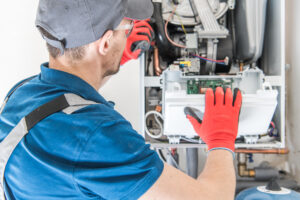Homeowner’s Guide to Furnace Flame Sensors
The flame sensor plays a crucial role in your furnace, safeguarding against gas leaks or potential explosions. Recognizing signs of a malfunctioning flame sensor and knowing exactly how to rectify it are essential for the safety of your home.
What is a Furnace Flame Sensor?
As the name suggests, the flame sensor detects when the furnace has a flame. If there is no flame, the sensor shuts the furnace off to prevent the risk of a gas leak. If the sensor doesn’t shut the furnace off, the furnace could continue running, putting your home at risk of an explosion or your household members at risk of carbon monoxide poisoning.
Types of Furnace Flame Sensors
Furnaces can have one of two types of flame sensors: an optimal reader or a bi-metallic strip. Both are responsible for emitting a small-voltage current, also known as a flame. Optimal readers are mostly used on industrial furnaces and can send out the amount of voltage needed for larger furnaces.
Bi-metallic strips send a smaller amount of voltage that’s needed in residential homes. When the strips feel the heat, they create voltage, also known as the flame.
Signs of a Faulty Flame Sensor
If a flame sensor stops working, it could endanger your house and family. Because gas doesn’t have a smell and is invisible, it could be hard to detect a problem until it’s too late. That’s why paying close attention to the flame sensor is important to your house and family’s well-being.
Here’s what to watch for:
- The furnace turns on and off frequently, not running for very long
- The porcelain surrounding the flame sensor is cracked
- The flame sensor has a black tip
- There is a lot of debris covering the sensor
- The flame sensor is corroded
Furnace Flame Sensor Replacement
Replacing the flame sensor can ensure your home and family’s safety. This is especially important if the sensor has a black tip or its casing is cracked. Because of the dangerous nature of furnace flame sensor replacement, consider hiring an HVAC professional to handle it.
If you decide you’re comfortable doing it yourself, use these steps:
- Read the owner’s manual to determine the flame sensor’s location
- Remove the access cover; this may require the use of a screwdriver
- Remove the flame sensor from the burner assembly
- Disconnect the wiring connecting the between the sensor and control box
- Remove and replace the flame sensor
Furnace Flame Sensor Replacement Cost
Most furnaces last 15 to 20 years with proper maintenance. However, a flame sensor usually lasts about five years. To ensure its longevity, it’s important to have regular HVAC inspections and cleanings.
To minimize the cost of replacing the furnace flame sensor, perform (or pay for) regular maintenance and cleaning. Full replacement costs between $80 and $250, depending on whether it’s an emergency service or performed during regular maintenance. Since a furnace flame sensor defect is an emergency, you’ll pay higher labor costs for the repair.
Maintenance Tips for Furnace Flame Sensors
To clean your furnace flame sensors, wait until the furnace hasn’t been running for at least 30 minutes. Next, turn the gas and electricity off running to the furnace. You can do this by turning off the furnace breaker and turning the valve handle on the gas pipe.
To clean the furnace flame sensor, remove it using the same steps as replacing it. First, remove the furnace access cover and unscrew the flame sensor. Disconnect the wiring and begin cleaning the sensor. It’s best to use an emery cloth to remove soot. Once clean, reconnect the wiring and place the sensor in the burner assembly.
While this can be a DIY job, consider hiring a professional to ensure it’s done right and the flame sensor works properly.
Conclusion
The furnace flame sensor is one of the most important parts of your furnace. Because of its importance and the danger involved in dealing with it, hiring a professional HVAC company to clean, maintain, and replace it is key. With a properly working furnace flame sensor, your furnace isn’t at risk of exploding or poisoning your household members with carbon monoxide.
If you’re ready to have your HVAC system cleaned, inspected, or repaired, get connected with a local pro.
FAQs
How much should it cost to replace a flame sensor on the furnace?
Flame sensor replacement can cost as little as $80. However, if you wait until it goes out and is an emergency, you may pay closer to $250 for the service.
How do I know if my furnace flame sensor is bad?
If you notice a cracked case around the sensor, a flame with a black tip, excessive debris around the sensor, or your furnace runs in frequent and short bursts, it could be a sign that the flame sensor is bad.
What is the life expectancy of a furnace flame sensor?
Most flame sensors last about five years, but it depends on the furnace brand, type, and level of maintenance you do. Expect to change the flame sensor at least twice in the furnace’s lifetime.
Can I run my furnace without a flame sensor?
It is very dangerous to run a furnace without a flame sensor. The sensor determines when the pilot light goes out, and the furnace should not run. Without a working sensor, your home is at risk of gas exploding or carbon monoxide poisoning.
What causes a flame sensor to go bad?
Many factors can cause a flame sensor to fail, including old age, excessive dirt and debris, corrosion, or a bad wire connection.
Check Out Additional HVAC Resources
- Things to Consider Before Replacing Your HVAC Unit
- 7 Signs to Call an HVAC Technicians
- HVAC Terms Homeowners Need to Know
- HVAC System Maintenance Checklist
- Main Types of HVAC Systems

Anna has over six years of experience in the home services and journalism industries and serves as the Content Manager at MyHomePros.com, specializing in making complex home improvement topics like HVAC, roofing, and plumbing accessible to all. With a bachelor’s degree in journalism from Auburn University, she excels in crafting localized, comprehensive guides that cater to homeowners’ unique needs. Living on both coasts of the United States has equipped her with a distinctive perspective, fueling her passion for turning any house into a cherished home through informed, personalized decision-making.









